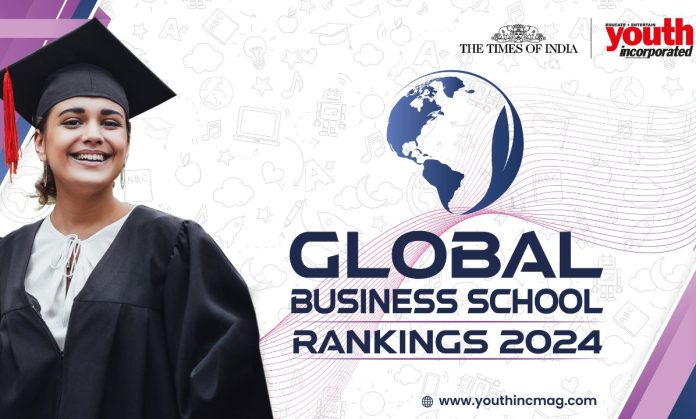The Indian economy has been one of the fastest-growing economies in the world for the past two years, emerging as a beacon of growth. The country’s prowess in technology and innovation was showcased in success stories such as the moon mission Chandrayaan-3. India has also cemented its position in international affairs by hosting the G20 Summit in 2023. With tech giants like Apple and Tesla wanting to expand their supplier networks in India and establishing manufacturing setups the global business landscape has witnessed significant change.
On the domestic level, shows like Shark Tank India have heavily encouraged the entrepreneurial spirit and given a boost to small startups. Appealing to the business acumen of the youth, the platform has catalyzed the pursuit of higher education among students. The show has become a cultural touchstone which has inspired the youth of today to consider business, finance, management, and marketing as a viable and exciting career path.
In terms of education trends, the appeal of a business career has never been stronger, as there has been a significant increase in the number of students who are drawn to the opportunities offered in the Indian business sector. According to the Education Testing Service (ETS) which conducts the Graduate Record Examination (GRE), said that the number of Indian students appearing for the exam has outstripped the number of American students, making India the largest GRE test-taker market in the world. This is a whopping 62% increase in Indian students who took the GRE this year. This marks as a testament to the growing awareness among Indian students of the global relevance of their education and the potential for an impact in terms of contributions to the world of business.
Adapting to the fast-paced and growing business world, universities worldwide constantly work towards providing the best set of skills and education for a lucrative career in this field. Our team connected with over 1,800 institutes across the world and held discussions with students, recruiters, and the teaching faculty, to present to you the top 100 Global B-School Rankings. We also consulted professional organizations such as AMBA, EQUIS, and AACSB. Youth Incorporated’s Research Unit (YRU) also studied domestic rankings in various countries to find the best institutes. The Global Business School Rankings 2024 are a testament to the growing synergy between global business trends and the aspirations of a generation with ambition.
The Global Business School Rankings 2024 have reflected greatly on London Business School, which has come to the top after retaining its position in the second for the past two years. Harvard University has climbed up from its third position in 2023, to the second position this year. Unfortunately, Stanford University has lost its crown and has fallen down to the third position this time. INSEAD has jumped up two positions in the past year, going from sixth in 2023 to fourth in 2024. After maintaining its seventh position for two years in a row, IE University has placed itself among the top five this time. Columbia University, on the other hand, held its position at fourth for two consecutive years and fell down to sixth this year. The University of Pennsylvania is slowly climbing the ladder, going ninth in 2022, eighth in 2023, and seventh in 2024. IIM Ahmedabad has made its mark by coming in the eighth position, jumping up from eleventh in 2023. Dartmouth College has shown remarkable improvement, going from the twenty-first position in 2023 to ninth this year. From being in the ninth position in 2023, Cornell has slipped down to the tenth position in 2024.
Looking at how the Indian business schools have fared this year, we see that the Indian Institute of Management (IIM) Ahmedabad has been making steady growth in the past three years, securing the eighth position this year, after holding the eleventh position in 2023 and fourteenth position in 2022. IIM Calcutta is also climbing up by securing the fifteenth position this year, in opposition to its nineteenth position in 2023. Under the top 50 category, apart from IIM Ahmedabad and IIM Calcutta, only the Indian School of Business has secured the 38th spot down from the 35th spot in 2023. SP Jain Institute of Management still hasn’t made it back in the top 50 category, maintaining its position fifty-sixth position this year as well.
The rankings show promise for Indian institutes for business, and it’s time Indian Business Schools rise back up to the top in 2025.
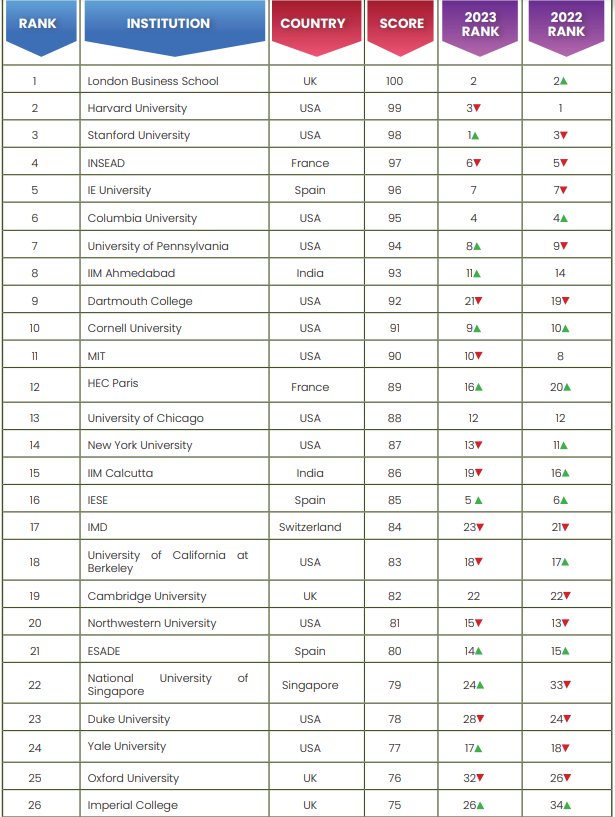
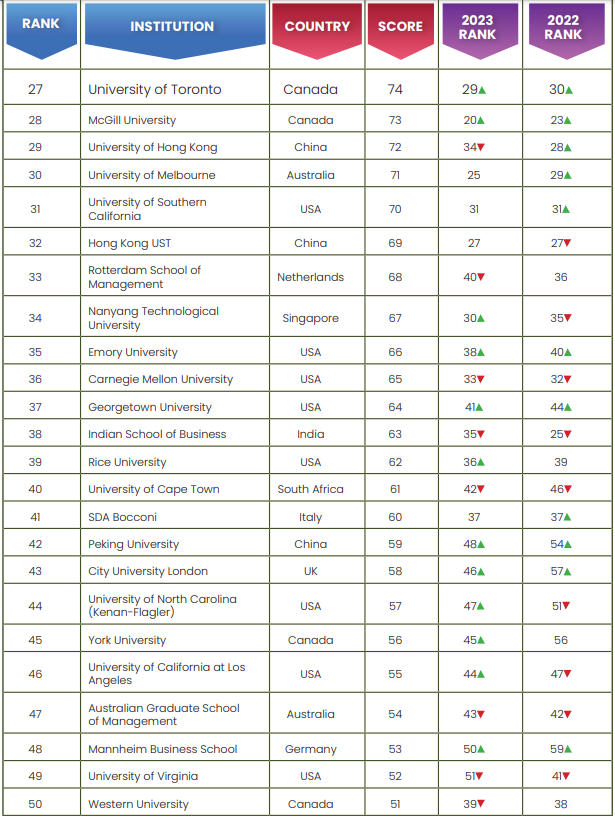
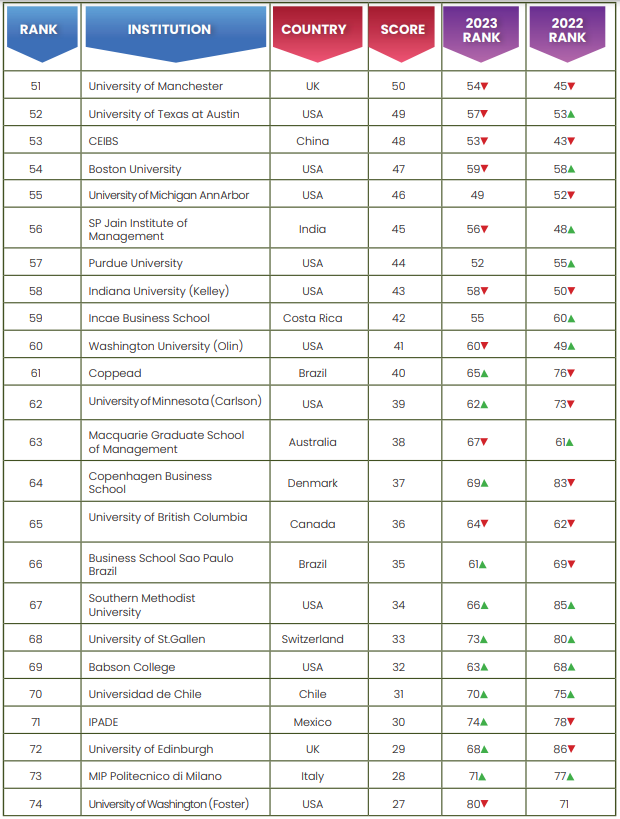
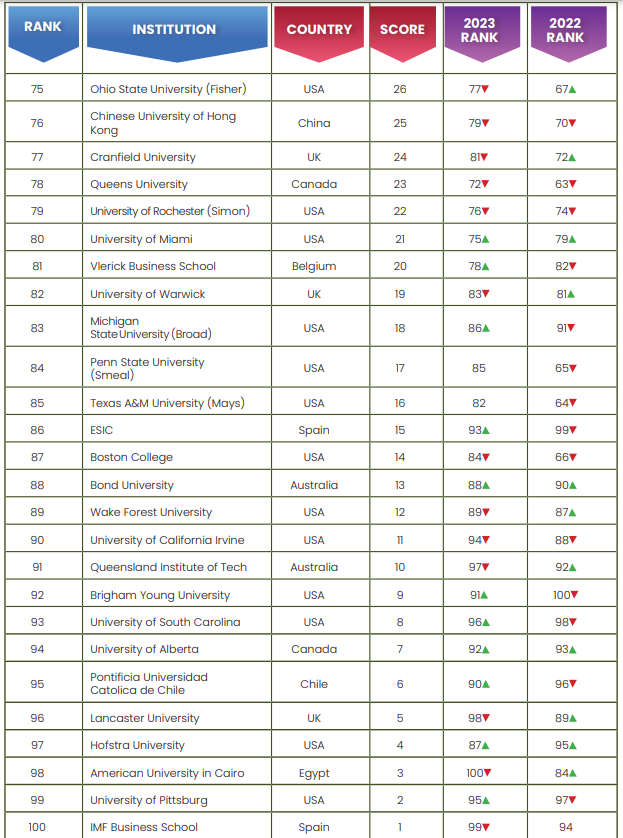
Ranking Methodology
How did we choose institutes?
We chose 1840 institutes across the world after having discussions with students, recruiters and faculty. We also consulted professional organizations such as AMBA, EQUIS and AACSB. Youth Inc’s Research Unit (YRU) also studied domestic rankings in various countries to find the best institutes.
All the institutes were sent identical surveys. We then contacted current students, alumni as well as local and international recruiters and gathered specific information about the institutes.
Factors considered
- Recruiter Perception – Identical surveys were sent to recruiters worldwide. The recruiters were asked to rate the institutes that they were most likely to recruit from. The recruiters were also asked to rate the students they have recruited from specific business schools on several criteria including leadership potential and strategic thinking.
- Diversity of Students – The institutes were asked to report the total number of students on campus and what percentage of the students were international and speak two or more languages. Gender diversity of the students was also considered.
- Diversity of Faculty – The institutes were asked to report the total number of faculty on campus and what percentage of the faculty was international, hold a doctorate degree and accredited with their own publishing material. Gender diversity of faculty was also considered.
- Innovation of Programs – We considered the different ways to construct degree programs as well as the choice students have in terms of selecting electives.
- Innovation in Teaching Methodologies – Institutes were asked to select different teaching methodologies that we considered innovative. Some of these included company visits, dual or multiple majors and course collaborations between different departments at the institute. Our list was selected after surveying students across different campuses worldwide.
- Value for Money – We considered students and alumni opinions on whether a particular institute was perceived as ‘value for money’. We also asked institutes to state the percentage of students who received some sort of funding from the institutes.
- Campus Support – We asked the institutes, current students and alumni to select the different types of assistance provided by the student office or a similar body on campus. Our list was selected after surveying students across different campuses worldwide.
- Career Service – We asked the institutes, current students and alumni about the availability and functioning of a career service cell and how active such a service was for the students. We also considered what percentage of students were actually placed through the institute’s career service cell, how long it look for such placements and what the average starting salaries were.
- Exchange Programs – Institutes were asked to report the percentage of students that opted for exchange programs. We also considered the exchange students present on the institute’s campus.
- Student Satisfaction – Current students and alumni were asked to rate their institutes on various factors including career services, attitude of staff and professors, location, and course content.
Actual Methodology
Institutes were provided a link using which they could send us their completed survey online. They were asked to answer questions relating to full time faculty, career service, student and program information and all the factors listed above.
We contacted current students and alumni of the institutes and asked them to rate specific statements which were pertaining to the factors we considered in this ranking. All the institutes preferred to send the survey links to their students and alumni directly.
Over 16300 recruiters were sent emails with a survey. The recruiter list was prepared from the responses of the institutes and also included internationally well known recruiters. The recruiters were asked to enlist institutes that they were likely to recruit from.
Below is a summary of the factors and the weightage given to each factor when we ranked the institutes:
| Information reported by the institute | Information reported by current students | Information reported by alumni | |
| Diversity of Students | 2% | 2% | 2% |
| Diversity of Faculty | 2% | 2% | 2% |
| Innovation of Programs | 2% | 2% | 2% |
| Innovation in Teaching Methodologies | 2% | 2% | 2% |
| Value for Money | 2% | 2% | 2% |
| Campus Support | 2% | 2% | 2% |
| Career Service | 4% | 4% | 4% |
| Exchange Programs | 2% | 2% | 2% |
| Student Satisfaction | 2% | 2% | 2% |
| 20% | 20% | 20% |
| Information reported by recruiters | |
| Recall of institute where to recruit from | 10% |
| Likelihood of recruiting from same institute again | 10% |
| Overall satisfaction with students recruited | 10% |
| Satisfaction with institute career cell | 10% |
| 40% |
Each factor was made up of a set of questions. The total percentage attributed to that factor was based on the average score of the responses multiplied by the assigned weight-age. We then totalled the score from all factors and sorted the scores from highest to lowest. The institute with the highest score was ranked 1st.
Not just numbers!
After we received the total computed scores for the institutes, we subjectively analyzed the data provided by the institutes, current students, alumni and recruiters. If we found discrepancies in the satisfaction scores and the subjective descriptions, we omitted the data.
Institutes that did not fill out the survey reports in time
Out of the institutes that were contacted, 154 institutes did not complete the survey on time or did not respond. We used publicly available information on the institutes to include some of them in our ranking. We also contacted current students, alumni and recruiters of these institutes and compared the data we received with the data from institutes that did participate.
Special notes
Masters in Finance – The programs include the pre-experience as well as the post-experience Masters programs. The ranking also includes the programs which are recently established.
Masters in Management – Certain Masters of Management programs with specializations are also included in the ranking.
Masters in Marketing – Combination courses of Marketing with communication and other fields are also included in the ranking.
Online MBA – Certain factors such as Campus Support and Exchange Programs were omitted in the factors considered for the ranking.
Executive MBA – Certain factors such as Campus Support and Exchange Programs were omitted in the factors considered for the ranking.




























